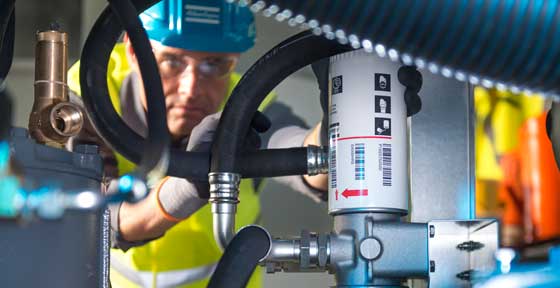A non-enclosed compressor is designed without a cabinet that surrounds the compressor’s critical components such as the motor, coolers and filters. The main advantage of a non-enclosed compressor is ease of maintenance, since the unit can be worked on without the need to remove body panels.
However, there are several disadvantages to a non-enclosed air compressor’s design.
- Without the sound-dampening effects of an enclosure or cabinet, non-enclosed air compressors are noisy. Therefore, hearing protection is usually required while in the compressor room or when working near the compressor. Expert Tip: To learn about other ways to reduce noise levels in your facility, check out our article, Sound Reduction: Six Ways to Turn Down the Noise.
- Dirt and moisture. The critical components of the air compressor, such as the motor, coolers and filters are susceptible to excessive dirt and moisture in non-enclosed compressor designs. Too much exposure to dirt and moisture can result in shorter service intervals and higher maintenance costs.
- Risk of damage. All components on non-enclosed air compressors are susceptible to breakage or damage from people, forklifts or other foreign objects that may come in contact with the air compressor. An enclosure can help prevent downtime from repairs or worse, a total replacement of damaged equipment.
- Less cooling efficiency. In a non-enclosed structure, there is no cooling air being directed across hot components, which could prevent the motor and other critical components from cooling to the desired level. When components continually operate at a high temperature, it can sacrifice the longevity of the components as well as decrease energy efficiency.
- Ducting difficulties. Ducting is recommended in applications where the environment is excessively dirty, wet, cold, or hot. It allows the compressor to bring in the cooling and inlet air from a separate location where the air is more desirable, as well as to exhaust the air into another location. Because there are no body or roof panels on a non-enclosed air compressor, it is more difficult to run ducting to the machine. It is also difficult to determine where the ducting should be placed in order to sufficiently direct air to and from the components that need it.
- Risk of dangerous oil leaks. Non-enclosed compressors are usually designed without oil-containing frames, which means oil will drop onto the floor of the facility if a leak occurs. Oil on the floor is a hazardous situation for employees and it also leaves undesirable stains on the floor.
- Possible premature motor failure. Many non-enclosed air compressors use open drip-proof (ODP) motors in their design. ODP motors are more susceptible to dirt, moisture, and overheating, which could result in premature motor failure. A motor with wet and dirty windings may also operate less efficiently.
Though the initial capacity and energy efficiency performance characteristics are the same between non-enclosed and enclosed compressors, there are many fundamental differences, some of which may affect long-term performance. Facility managers should consider the pros and cons of both enclosed and non-enclosed compressors in areas such as safety, ease of maintenance and profitability before choosing a specific compressor design.
Learn more about Atlas Copco’s energy efficient air compressors and air treatment equipment by contacting us or by visiting our website, www.atlascopco.us. You may also be interested in the following articles:
- Toxicology Lab Benefits from On-Site Nitrogen Generation, Part II
- Toxicology Lab Benefits from On-Site Nitrogen Generation, Part I
- Atlas Copco Brings Innovative Vacuum Pumps, Compressors to AWFS 2015
Source: Compressed Air Blog


